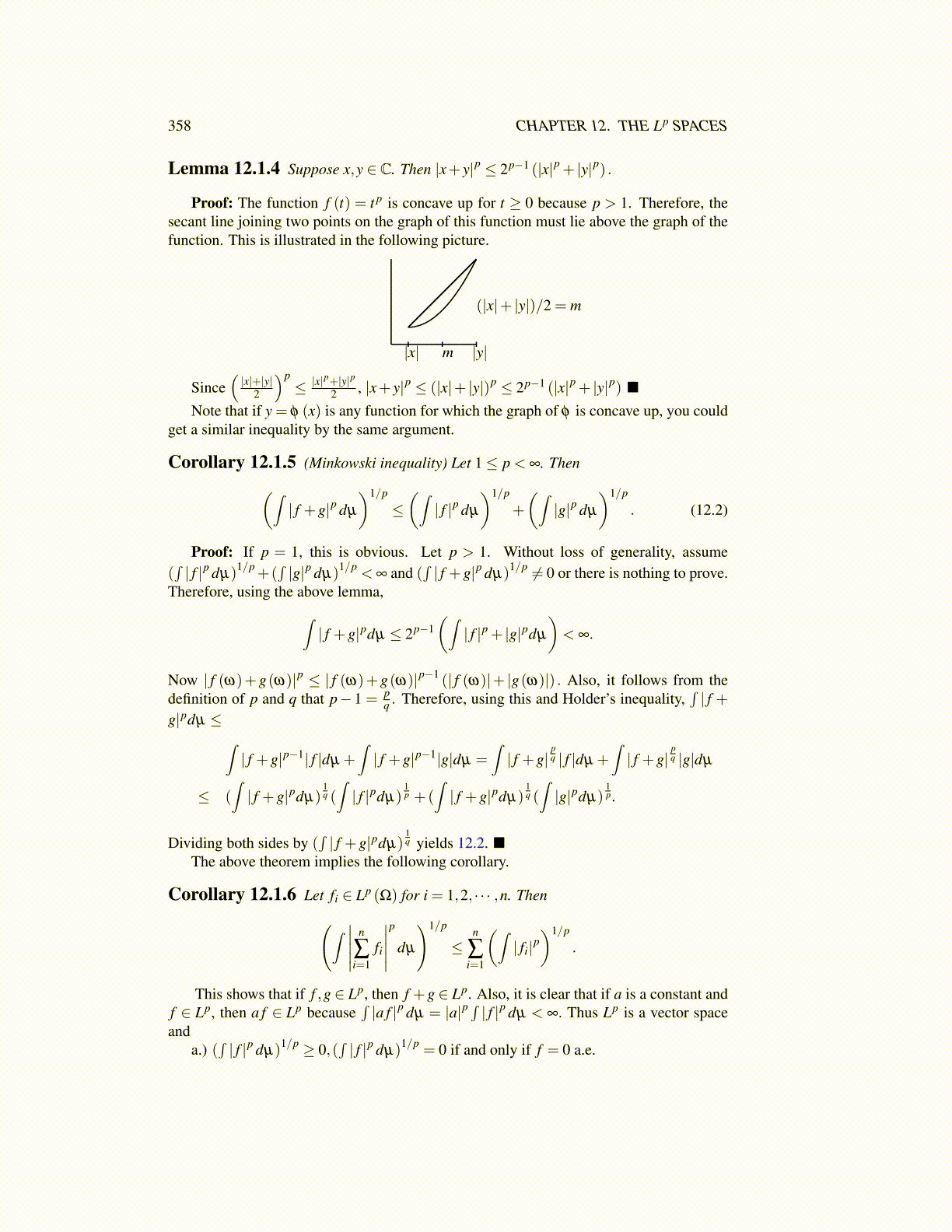
358 CHAPTER 12. THE Lp SPACES
Lemma 12.1.4 Suppose x,y ∈ C. Then |x+ y|p ≤ 2p−1 (|x|p + |y|p) .
Proof: The function f (t) = t p is concave up for t ≥ 0 because p > 1. Therefore, thesecant line joining two points on the graph of this function must lie above the graph of thefunction. This is illustrated in the following picture.
|x| |y|m
(|x|+ |y|)/2 = m
Since(|x|+|y|
2
)p≤ |x|
p+|y|p2 , |x+ y|p ≤ (|x|+ |y|)p ≤ 2p−1 (|x|p + |y|p) ■
Note that if y = φ (x) is any function for which the graph of φ is concave up, you couldget a similar inequality by the same argument.
Corollary 12.1.5 (Minkowski inequality) Let 1≤ p < ∞. Then(∫| f +g|p dµ
)1/p
≤(∫| f |p dµ
)1/p
+
(∫|g|p dµ
)1/p
. (12.2)
Proof: If p = 1, this is obvious. Let p > 1. Without loss of generality, assume(∫| f |p dµ)1/p+(
∫|g|p dµ)1/p < ∞ and (
∫| f +g|p dµ)1/p ̸= 0 or there is nothing to prove.
Therefore, using the above lemma,∫| f +g|pdµ ≤ 2p−1
(∫| f |p + |g|pdµ
)< ∞.
Now | f (ω)+g(ω)|p ≤ | f (ω)+g(ω)|p−1 (| f (ω)|+ |g(ω)|) . Also, it follows from thedefinition of p and q that p−1 = p
q . Therefore, using this and Holder’s inequality,∫| f +
g|pdµ ≤ ∫| f +g|p−1| f |dµ +
∫| f +g|p−1|g|dµ =
∫| f +g|
pq | f |dµ +
∫| f +g|
pq |g|dµ
≤ (∫| f +g|pdµ)
1q (∫| f |pdµ)
1p +(
∫| f +g|pdµ)
1q (∫|g|pdµ)
1p.
Dividing both sides by (∫| f +g|pdµ)
1q yields 12.2. ■
The above theorem implies the following corollary.
Corollary 12.1.6 Let fi ∈ Lp (Ω) for i = 1,2, · · · ,n. Then(∫ ∣∣∣∣∣ n
∑i=1
fi
∣∣∣∣∣p
dµ
)1/p
≤n
∑i=1
(∫| fi|p
)1/p
.
This shows that if f ,g ∈ Lp, then f +g ∈ Lp. Also, it is clear that if a is a constant andf ∈ Lp, then a f ∈ Lp because
∫|a f |p dµ = |a|p
∫| f |p dµ < ∞. Thus Lp is a vector space
anda.) (
∫| f |p dµ)1/p ≥ 0,(
∫| f |p dµ)1/p = 0 if and only if f = 0 a.e.